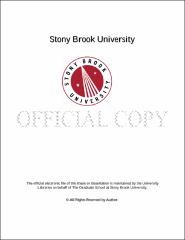| dc.identifier.uri | http://hdl.handle.net/11401/75984 | |
| dc.description.sponsorship | This work is sponsored by the Stony Brook University Graduate School in compliance with the requirements for completion of degree. | en_US |
| dc.format | Monograph | |
| dc.format.medium | Electronic Resource | en_US |
| dc.language.iso | en_US | |
| dc.publisher | The Graduate School, Stony Brook University: Stony Brook, NY. | |
| dc.type | Dissertation | |
| dcterms.abstract | Hunter-gatherers spread to nearly every corner of the planet in large part due to their flexible ability to forage for high-quality foods in diverse environments. The study of human foraging behavior is therefore crucial to understanding the proximate and ultimate factors that have shaped human evolutionary history. Although not necessarily in an evolutionary context, the foraging behavior of Paleoindian hunter-gatherers in North America has been studied for over a century. Researchers have paid particular attention to Paleoindian foragers’ hunting of big game across the grasslands of the Great Plains, shedding light on “what†prey Paleoindians foraged, “where†foraging occurred on the paleolandscape, and “how†foraging took place. Less, however, is known about the forces shaping those foraging responses. Although prey abundance has emerged as an important factor determining predator responses, quantitative studies on Paleoindian predators’ foraging decisions related to prey abundance have been less developed. In effect, only infrequent and tenuous answers have emerged in response to the question of why archaeologically observed predator–prey interactions occurred. This dissertation addresses questions regarding Paleoindian foraging behavior by developing new tools 1) to investigate the general factors shaping hunter-gatherer foraging decisions, and more specifically, 2) to reconstruct a baseline of the bison prey abundance available to Paleoindian hunter-gatherers, particularly across the North American Great Plains. These tools are then used to test several of the current hypotheses regarding the relationship between Paleoindian predators, their environment, and their prey. These include hypotheses generated from traditional research on Paleoindian hunting, as well as hypotheses derived from foraging theory. | |
| dcterms.available | 2017-09-18T23:49:43Z | |
| dcterms.contributor | Shea, John J. | en_US |
| dcterms.contributor | Smaers, Jeroen B. Twiss, Katheryn C | en_US |
| dcterms.contributor | Kramer, Karen L. | en_US |
| dcterms.creator | Otárola-Castillo, ErikRoque | |
| dcterms.creator | Otárola-Castillo, ErikRoque | |
| dcterms.dateAccepted | 2017-09-18T23:49:43Z | |
| dcterms.dateSubmitted | 2017-09-18T23:49:43Z | |
| dcterms.description | Department of Anthropology | en_US |
| dcterms.extent | 310 pg. | en_US |
| dcterms.format | Monograph | |
| dcterms.format | Application/PDF | en_US |
| dcterms.identifier | http://hdl.handle.net/11401/75984 | |
| dcterms.issued | 2016-12-01 | |
| dcterms.language | en_US | |
| dcterms.provenance | Made available in DSpace on 2017-09-18T23:49:43Z (GMT). No. of bitstreams: 1
OtxE1rolaCastillo_grad.sunysb_0771E_13188.pdf: 6505920 bytes, checksum: fa13d271ac0bb7ebcaf929a9059e516f (MD5)
Previous issue date: 42370 | en |
| dcterms.publisher | The Graduate School, Stony Brook University: Stony Brook, NY. | |
| dcterms.title | A spatio-temporal model of hunter-gatherer foraging ecology across the North American Great Plains throughout the Paleoindian period: Development of biological theory and statistical methods to link human evolutionary biology, ecology, and the archaeological record | |
| dcterms.type | Dissertation | |

